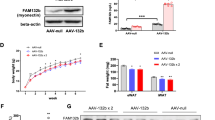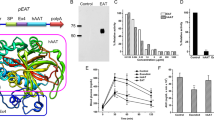Abstract
Apolipoprotein E (apoE) is a multifunctional plasma glycoprotein involved in lipoprotein metabolism and a range of cell signalling phenomena. ApoE-deficient (apoE-/-) mice exhibit severe hypercholesterolaemia and are an excellent model of human atherosclerosis. ApoE somatic gene transfer and bone marrow transplantation in apoE-/- mice results in reversal of hypercholesterolaemia, inhibition of atherogenesis and regression of atherosclerotic plaque density. Replication defective adeno-associated virus vectors (rAAVs) are an attractive system currently in clinical trial for muscle-based heterologous gene therapy to express secreted recombinant plasma proteins. Here we have applied rAAV transduction of skeletal muscle to express wild-type (ɛ3) and a defective receptor-binding mutant (ɛ2) human apoE transgene in apoE-/- mice. In treated animals, apoE mRNA was present in transduced muscles and, although plasma levels of recombinant apoE fell below the detection levels of our ELISA (ie <10 ng/ml), circulating antibodies to human apoE and rAAV were induced. Up to 3 months after a single administration of rAAV/apoE3, a significant reduction in atherosclerotic plaque density in aortas of treated animals was observed (approximately 30%), indicating that low-level rAAV-mediated apoE3 expression from skeletal muscle can retard atherosclerotic progression in this well-defined genetic model.
This is a preview of subscription content, access via your institution
Access options
Subscribe to this journal
Receive 12 print issues and online access
$259.00 per year
only $21.58 per issue
Buy this article
- Purchase on Springer Link
- Instant access to full article PDF
Prices may be subject to local taxes which are calculated during checkout






Similar content being viewed by others
References
Breslow J.L. . Cardiovascular disease burden increases, NIH funding decreases Nat Med 1997 3: 600 600
SoRelle R. . From global to microscopic views of cardiovascular disease Circulation 1999 99: 3 3
SoRelle R. . From global to microscopic views of cardiovascular disease
Petersen S, Rayner M, Press V. Coronary heart disease statistics. British Heart Foundation Statistics Database. 2000: 10 Nature 1993 362: 801 801
Glomset J.A. . The plasma lecithin: cholesterol acyl transferase reaction J Lipid Res 1968 9: 155 155
Mahley R.W. . Apolipoprotein E: cholesterol transport protein with expanding role in cell biology Science 1998 240: 622 622
Fielding C.J., Fielding P.E. . Molecular physiology of reverse cholesterol transport J Lipid Res 1995 36: 211 211
Mahley R.W., Ji Z.-S. . Remnant lipoprotein metabolism: key pathways involving cell-surface heparan sulfate proteoglycans and apolipoprotein E J Lipid Res 1999 40: 1 1
Davignon J., Gregg R.E., Sing C.F. . Apolipoprotein E polymorphism and arteriosclerosis Arteriosclerosis 1988 8: 1 1
Huang Y. et al. A plasma lipoprotein containing only apolipoprotein E and with γ mobility on electrophoresis releases cholesterol from cells Proc Natl Acad Sci USA 1994 91: 1834 1834
Huang Y., Von Eckardstein A., Wu S., Assmann G. . Effects of the apolipoprotein E polymorphism on uptake and transfer of cell-derived cholesterol in plasma J Clin Invest 1995 96: 2693 2693
Von Eckardstein A. . Cholesterol efflux from macrophages and other cells Curr Opin Lipidol 1996 7: 89 89
de Knijff P., van den Maagdenberg A.M.J.M., Frants R.R., Havekes L.M. . Genetic heterogeneity of apolipoprotein E and its influence on plasma lipid and lipoprotein levels Hum Mutat 1994 4: 178 178
Miyata M., Smith J.D. . Apolipoprotein E allele-specific antioxidant activity and effects on cytotoxicity by oxidative insults and β-amyloid peptides Nat Genet 1996 14: 55 55
Schaefer E.J. et al. Familial apolipoprotein E deficiency J Clin Invest 1986 78: 1206 1206
Piedrahita J.A. et al. Generation of mice carrying a mutant apolipoprotein E gene inactivated by gene targeting in embryonic stem cells Proc Natl Acad Sci USA 1992 89: 4471 4471
Nakashima Y. et al. ApoE-deficient mice develop lesions of all phases of atherosclerosis throughout the arterial tree Arterioscler Thromb Vasc Biol 1994 14: 133 133
Boisvert W.A., Spangenberg J., Curtiss L.K. . Treatment of severe hypercholesterolemia in apolipoprotein E-deficient mice by bone marrow transplantation J Clin Invest 1995 96: 1118 1118
Linton M.F., Atkinson J.B., Fazio S. . Prevention of atherosclerosis in apolipoprotein E-deficient mice by bone marrow transplantation Science 1995 267: 1034 1034
Kashyap V.S. et al. Apolipoprotein E deficiency in mice: gene replacement and prevention of atherosclerosis using adenovirus vectors J Clin Invest 1995 96: 1612 1612
Stevenson S.C. et al. Phenotypic correction of hypercholesterolemia in apoE-deficient mice by adenovirus-mediated in vivo gene transfer Arterioscler Thromb Vasc Biol 1995 15: 479 479
Tsukamoto K. et al. Rapid regression of atherosclerosis induced by liver-directed gene transfer of apoE in apoE-deficient mice Arterioscler Thromb Vasc Biol 1999 19: 2162 2162
Athanasopoulos T. et al. Intramuscular injection of a plasmid vector expressing human apolipoprotein E limits progression of xanthoma and aortic atheroma in apoE-deficient mice Hum Mol Genet 2000 9: 2545 2545
Yang Y. et al. Cellular immunity to viral antigens limits E1-deleted adenoviruses for gene therapy Proc Natl Acad Sci USA 1994 91: 4407 4407
Yang Y. et al. Immune responses to viral antigens versus transgene product in the elimination of recombinant adenovirus-infected hepatocytes in vivo Gene Therapy 1996 3: 137 137
Desurmont C. . Complete atherosclerosis regression after human apoE gene transfer in apoE-deficient/nude mice Arterioscler Thromb Vasc Biol 2000 20: 435 435
Berns K.I., Linden R.M. . The cryptic lifestyle of adeno-associated virus Bioessays 1995 17: 237 237
Samulski R.J., Chang L.S., Shenk T. . Helper-free stocks of recombinant adeno-associated viruses: normal integration does not require viral gene expression J Virol 1989 63: 3822 3822
Kessler P.D. . Gene delivery to skeletal muscle results in sustained expression and systemic delivery of a therapeutic protein Proc Natl Acad Sci USA 1996 93: 14082 14082
Blau H.M., Springer M. . Muscle-mediated gene-therapy N Engl J Med 1995 333: 1554 1554
Xiao X., Li J., Samulski R.J. . Efficient long-term gene transfer into muscle tissue of immunocompetent mice by adeno-associated virus vector J Virol 1996 70: 8098 8098
Fisher K.J. et al. Recombinant adenoassociated virus for muscle directed gene therapy Nat Med 1997 3: 306 306
Clark R.K., Sferra T.J., Johnson P.R. . Recombinant adeno-associated viral vectors mediate long-term transgene expression in muscle Hum Gene Ther 1997 8: 659 659
Herzog R.W. et al. Stable gene transfer and expression of human blood coagulation factor IX after intramuscular injection of recombinant adeno-associated virus Proc Natl Acad Sci USA 1997 94: 5804 5804
Snyder R.O. et al. Efficient and stable adeno-associated virus-mediated transduction in the skeletal muscle of adult immunocompetent mice Hum Gene Ther 1997 8: 1891 1891
Fabb S.A., Dickson J.G. . Technology evaluation: AAV Factor IX gene therapy, Avigen Inc. Curr Opin Mol Ther 2000 2: 1464 1464
Plump A.S. et al. Severe hypercholesterolemia and atherosclerosis in apolipoprotein E-deficient mice created by homologous recombination in ES cells Cell 1992 71: 343 343
Zhang S.H. et al. Spontaneous hypercholesterolemia and arterial lesions in mice lacking apolipoprotein E Science 1992 258: 468 468
Hasty A.H. et al. Retroviral gene therapy in apoE-deficient mice: apoE expression in the artery wall reduces early foam cell lesion formation Circulation 1999 99: 2571 2571
Tsukamoto K., Smith P., Glick J.M., Rader D.J. . Liver-directed gene transfer and prolonged expression of three major human apoE isoforms in apoE-deficient mice J Clin Invest 1997 100: 107 107
Rinaldi M. et al. Treatment of severe hypercholesterolemia in apolipoprotein E-deficient mice by intramuscular injection of plasmid DNA Gene Therapy 2000 7: 1795 1795
Fan L. et al. Efficient coexpression and secretion of anti-atherogenic human apolipoprotein A1 and lecithin-cholesterol acyltransferase by cultured muscle cells using adeno-associated virus plasmid vectors Gene Therapy 1998 5: 1434 1434
Herzog R.W. et al. Long-term correction of canine hemophilia B by gene transfer of blood coagulation factor IX-mediated by adeno-associated viral vector Nat Med 1999 56: 56 56
Joos K., Yang Y., Fisher K.J., Wilson J.M. . Transduction of dendritic cells by DNA viral vectors directs the immune response to transgene products in muscle fibers J Virol 1998 72: 4212 4212
Thorngate F.E., Rudel L.L., Walzem R.L., Williams D.L. . Low levels of extrahepatic nonmacrophage apoE inhibit atherosclerosis without correcting hypercholesterolemia in ApoE-deficient mice Arterioscler Thromb Vasc Biol 2000 20: 1939 1939
Tamminen M. et al. Ultrastructure of early lipid accumulation in apoE deficient mice Arterioscler Thromb Vasc Biol 1999 19: 847 847
Riddell D.R., Graham A., Owen J.S. . Apolipoprotein E Inhibits platelet aggregation through the L-arginine:nitric oxide pathway J Biol Chem 1997 272: 89 89
Kelly M.E. et al. Apolipoprotein E inhibition of proliferation of mitogen-activated T lymphocytes: production of interleukin 2 with reduced biological activity Cell Immunol 1994 159: 124 124
Ishigami M. et al. Apolipoprotein E inhibits platelet-derived growth factor-induced vascular smooth muscle cell migration and proliferation by suppressing signal transduction and preventing cell entry to G1 phase J Biol Chem 1998 273: 20156 20156
Nakashima Y. et al. Upregulation of VCAM-1 and ICAM-1 at atherosclerosis-prone sites on the endothelium in the apoE-deficient mouse Arterioscler Thromb Vasc Biol 1998 18: 842 842
Faggiotto A., Poli A., Catapano A.L. . Antioxidants and coronary artery disease Curr Opin Lipidol 1998 9: 541 541
Mahley R.W., Huang Y., Rall S.C. Jr . Pathogenesis of type III hyperlipoproteinemia (dysbetalipoproteinemia): questions, quandaries, and paradoxes J Lipid Res 1999 40: 1933 1933
Weisgraber K.H., Innerarity T.L., Mahley R.W. . Abnormal lipoprotein receptor-binding activity of the human E apolipoprotein due to cysteine–arginine interchange at a single site J Biol Chem 1982 257: 2518 2518
Manning W.C. et al. Transient immunosuppression allows transgene expression following readministration of adeno-associated viral vectors Hum Gene Ther 1998 9: 477 477
Chao H. et al. Several increase in therapeutic transgene delivery by distinct adeno-associated viral serotype vectors Mol Ther 2000 2: 619 619
Pruchnic R. et al. The use of adeno-associated virus to circumvent the maturation-dependent viral transduction of muscle fibres Hum Gene Ther 2000 11: 521 521
Breslow J.L. et al. Identification and DNA sequence of a human apolipoprotein E cDNA clone J Biol Chem 1982 257: 14639 14639
Grimm D. et al. Novel tools for production and purification of recombinant adenoassociated virus vectors Hum Gene Ther 1998 9: 2745 2745
Pear W.S., Nolan G.P., Scott M.L., Baltimore D. . Production of high-titre helper-free retroviruses by transient transfection Proc Natl Acad Sci USA 1993 90: 8392 8392
Zolotukhin S. et al. Recombinant adeno-associated virus purification using novel methods improves infectious titer and yield Gene Therapy 1999 6: 973 973
Zolotukhin S. et al. Recombinant adeno-associated virus purification using novel methods improves infectious titer and yield
Snyder RO, Xiao X, Samulski RJ. Production of recombinant adeno-associated viral vectors. In: Dracopoli NC et al (eds). Current Protocols in Human Genetics, John Wiley & Sons: New York, 1996, pp 12.1.11–12.1.15 J Lipid Res 1990 31: 545 545
Tagalakis A.D. et al. Gene correction of the apolipoprotein (apo) E2 phenotype to wild-type apoE3 by in situ chimeraplasty J Biol Chem 2001 276: 13226 13226
Riddell D.R., Sheikh S., James R.W., Owen J.S. . Native immunoaffinity-isolated apolipoprotein E-containing high-density lipoprotein particles inhibit platelet aggregation Biochem Soc Trans 1996 24: 454S 454S
Acknowledgements
Parts of this work were supported by grants from the British Heart Foundation, Sir Jules Thorn Charitable Trust, European Union and Wellcome Trust. We gratefully thank J Kleinschmidt and D Grimm for providing the pDG plasmid and JL Breslow for providing the human apoE2 and apoE3 cDNAs. We thank A Tagalakis for providing the partially-purified recombinant apoE.
Author information
Authors and Affiliations
Rights and permissions
About this article
Cite this article
Harris, J., Schepelmann, S., Athanasopoulos, T. et al. Inhibition of atherosclerosis in apolipoprotein-E-deficient mice following muscle transduction with adeno-associated virus vectors encoding human apolipoprotein-E. Gene Ther 9, 21–29 (2002). https://doi.org/10.1038/sj.gt.3301615
Received:
Accepted:
Published:
Issue Date:
DOI: https://doi.org/10.1038/sj.gt.3301615
Keywords
This article is cited by
-
StAR Overexpression Decreases Serum and Tissue Lipids in Apolipoprotein E‐deficient Mice
Lipids (2009)
-
Applied gene therapy in preclinical models of vascular injury
Current Atherosclerosis Reports (2003)



